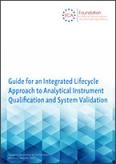ECA新指南《分析仪器确认和系统验证的综合生命周期方法》

In the laboratories of the pharmaceutical quality control there is a large number of analytical instruments that have to be qualified according to the GMP Guidelines and maintained in this qualified state. To achieve this, it is necessary to define, manage, and document the type, extent, and processes for qualification, calibration, and control of inspection, measuring, and testing equipment in a traceable manner. This is required both for internal purposes and for external bodies such as clients and regulatory authorities.
Analytical Instrument Qualification (AIQ) includes the process which guarantees that an analytical instrument performs suitably for its intended purpose. Use of a qualified instrument in analyses contributes to confidence in the validity of generated data.
System Validation (SV) is the documented process carried out in order to guarantee that a computerized system works properly, and that it complies with the defined requirements and provisions.
4Q模型:确认通常分为四个阶段:
1. Design Qualification (DQ): Documented collection of activities that define the functional and operational specifications and intended use of the instrument.
2. Installation Qualification (IQ): Assurance that the instrument is delivered as designed and specified, is properly installed in the selected environment, and that this environment is suitable for the instrument.
运行确认(OQ):确认仪器将在选定的环境中根据其运行规范进行测试。
性能确认(PQ):确认仪器在实际操作环境中符合用户定义的规格和要求。
Transferring these requirements to the qualification of analytical instruments may result in various challenges. One essential point is that laboratories usually choose from instruments available on the market and don't develop the design themselves. Furthermore, the 4Qs model sometimes proves to be too rigid, especially in its application to computerized systems. In practice it is often difficult to clearly define the difference between the activities in the OQ stage and the PQ stage.
Against this background the ECA Analytical Quality Control Group (AQCG) has published a new guide with the title "Guide for an Integrated Lifecycle Approach to Analytical Instrument Qualification and System Validation". This Guide offers scientifically substantiated qualification strategies which also take into consideration the intended use of the instrument or system. The lifecycle approach presented in the new Guide deliberately deviates from the 4Qs model with its four stages.
新指南的结构和内容
Dr Christopher Burgess (Chairman of the ECA AQCG-Board) and Dr Bob McDowall (Board Member of the AQCG and Board Member of the ECA Data Integrity & IT Compliance Interest Group)had leading roles in preparing the document. The Guide comprises 153 pages altogether and is divided into twelve main chapters and six illustrative „How To“ appendices. Furthermore, the guide contains a technical glossary with 19 pages, 111 references, 38 figures and 24 overview tables that further illustrate and elaborate the contents.
The Guide offers a more flexible approach which aims to provide a uniform lifecycle model suited for analytical instruments as well as for computerized laboratory systems while putting the main focus on instruments operated according to the GMP regulations. The approach takes into account the proposals which are currently discussed within the framework of the revision of USP General Chapter.
The Guide also refers to other regulations and standards such as the US GMP 21 CFR 211, the EU GMP Guidelines Parts 1 and 2, the USP General Chapter (Analytical Instrument Qualification), the GAMP Guide and relevant ISO standards.
After presenting in detail the specific roles and responsibilities of the different stakeholders, including laboratory, quality assurance, procurement, suppliers and contracting parties it is outlined why the Analytical Instrument Qualification and System Validation (AIQSV) as integral part of the Analytical Procedure Lifecycle (APL) is indispensable for ensuring data integrity. Moreover, the difference between „fitness for intended use“ and „fitness for intended purpose“ is explained, and the importance of a structured lifecycle process is highlighted.
The chapter „Risk-Based Classification of Analytical Instruments and Systems“ explains the risk-based classification according to the USP General Chapter . Analytical instruments and systems are divided into three main groups which may be further differentiated according to their use. Based on this follows the presentation of a risk-based system for the classification of the instruments into these groups. The Guide is not based on the 4Qs model (DQ, IQ, OQ and PQ) but proposes instead a flexible AIQSV lifecycle stage model which is based on an article on the revision of the USP General Chapter from the year 2022.
Subsequently, the three lifecycle stages are discussed: Stage 1 (Specification and Selection), Stage 2 (Qualification/Validation of Instruments and Systems), and Stage 3 (Continued Performance Verification). The Guide emphasizes the importance of the User Requirements Specification (URS), and highlights the fact that the URS may change in the course of the lifecycle and should, therefore, be regarded as a „living“ document. Depending on the classification into the groups A, B or C the requirements in this stage may range from a simple monitoring to a comprehensive qualification of the instrument and validation of the control software. In stage 3 special attention needs to be paid to the routine monitoring by means of trend analysis, to the change management in the case of software updates as well as to the backup and archiving of the data generated.
该指南的附录
The so-called „How to“ appendices are an important component of the Guide. These appendices aim to apply the aspects described in the main chapters to concrete examples of apparatuses, instruments and systems. For this, examples were chosen from all three USP groups and their sub-groups starting with apparatuses from group A1 (vortex mixer) up to group C3 (NIR spectrometer for identification of raw materials). These appendices offer practical instructions for the application of the Guide’s theoretical principles to the specific requirements and challenges concerning the qualification and validation of different laboratory apparatuses and systems.
The guide can be downloaded as PDF file in the members' area on the AQCG website (www.analytical-quality-control-group.org).
https://www.gmp-journal.com/current-articles/details/analytical-instrument-qualification-and-system-validation.html

全部 0条评论